Since supper there are signs of clearing again, but I don’t like the look of things; this weather has been working up from the S.E. with all the symptoms of our pony-wrecking storm. Pray heaven we are not going to have this wretched snow in the worst part of the glacier to come. The lower part of this glacier is not very interesting, except from an ice point of view. Except Mount Kyffen, little bare rock is visible, and its structure at this distance is impossible to determine. There are no moraines on the surface of the glacier either. The tributary glaciers are very fine and have cut very deep courses, though they do not enter at grade. The walls of this valley are extraordinarily steep; we count them at least 60 deg. in places. The ice-falls descending over the northern sides are almost continuous one with another, but the southern steep faces are nearly bare; evidently the sun gets a good hold on them. There must be a good deal of melting and rock weathering, the talus heaps are considerable under the southern rock faces. Higher up the valley there is much more bare rock and stratification, which promises to be very interesting, but oh! for fine weather; surely we have had enough of this oppressive gloom.
Saturday, December 16.—Camp 38. A gloomy morning, clearing at noon and ending in a gloriously fine evening. Although constantly anxious in the morning, the light held good for travelling throughout the day, and we have covered 11 miles (stat.), altering the aspect of the glacier greatly. But the travelling has been very hard. We started at 7, lunched at 12.15, and marched on till 6.30—over ten hours on the march—the limit of time to be squeezed into one day. We began on ski as usual, Evans’ team hampering us a bit; the pulling very hard after yesterday’s snowfall. In the afternoon we continued on ski till after two hours we struck a peculiarly difficult surface—old hard sastrugi underneath, with pits and high soft sastrugi due to very recent snowfalls. The sledges were so often brought up by this that we decided to take to our feet, and thus made better progress, but for the time with very excessive labour. The crust, brittle, held for a pace or two, then let one down with a bump some 8 or 10 inches. Now and again one’s leg went down a crack in the hard ice underneath. We drew up a slope on this surface and discovered a long icefall extending right across our track, I presume the same pressure which caused Shackleton to turn towards the Cloudmaker. We made in for that mountain and soon got on hard, crevassed, undulating ice with quantities of soft snow in the hollows. The disturbance seems to increase, but the snow to diminish as we approach the rocks. We shall look for a moraine and try and follow it up to-morrow. The hills on our left have horizontally stratified rock alternating with snow. The exposed rock is very black; the brownish colour of the Cloudmaker has black horizontal streaks across it. The sides of the glacier north of the Cloudmaker have a curious cutting, the upper part less steep than the lower, suggestive of different conditions of glacier-flow in succeeding ages.




